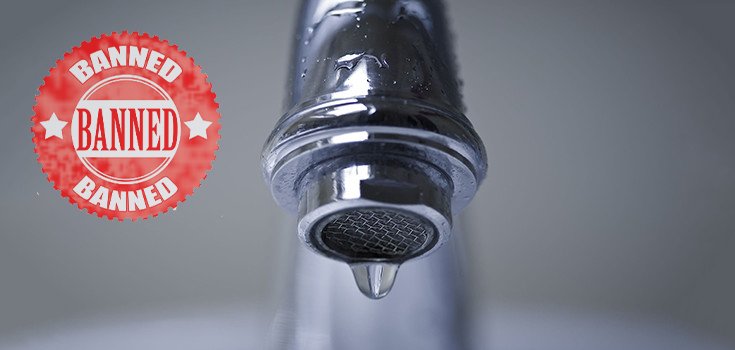Citizens in These 3 US States Took Action on Water Fluoridation Bans

Voters in Kennebunk, Kennebunkport, and Wells Water District in Maine; Healdsburg, California (Sonoma County); and Greenville, Texas went to the polls on November 8 to voice their views on whether to ban fluoride in their drinking water.
Fluoride was added to the U.S. water supply purportedly to ward off cavities. However, some research does suggest that water fluoridation does nothing to improve dental health. In fact, countries with fluoridated water do not have less tooth decay than non-fluoridated countries. [1]
Furthermore, about 40% of American teens show signs of fluoride over-exposure, or dental fluorosis. Fluorosis is a tooth enamel defect that makes the teeth look like they are covered in cloudy spots and streaks. In more severe cases, fluorosis results in brown stains and tooth erosion.
Nobody wants to get their teeth drilled or have a root canal, but the health risks associated with fluoride are far worse than holes in your teeth:
- Arthritis
- Bone fractures
- Brain effects
- Cancer
- Cardiovascular Disease
- Diabetes
- Endocrine disruption
- Gastrointestinal problems
- Hypersensitivity
- Kidney disease
- Male Infertility
- Pineal gland damage
- Skeletal fluorosis
- Thyroid disease
- Acute toxicity
In the spring of 2015, the U.S. government lowered fluoride levels in drinking water for the first time in 50 years, after researchers at Harvard University and other institutions found that exposure to high levels of fluoride can cause numerous health problems and lower IQ.

Let’s take a look at how these communities voted.
Maine
Residents of 7 towns – Kennebunk, Kennebunkport, Wells, Ogunquit, Arundel and parts of Biddeford and York – voted to stop treating drinking water with fluoride. All of the communities get their drinking water from the Wells Water District. [2]
District superintendent Norm Labbe said in a statement:
“The Water District is pleased with the outcome of the fluoride referendum.
It’s evident that the voting public is now more informed about the subject than they were back in 2002, when fluoridation was voted in. The water district thanks the Campaign to Reconsider Water Fluoridation volunteers and in particular the voters for their knowledgeable decision to cease the addition of fluoride to our water.
We look forward to staying true to our mission of providing the highest quality of water at the lowest reasonable cost.”
The ballot referendum was the work of the Campaign to Reconsider Fluoride, a small group of concerned residents who are concerned that water fluoridation equates to mass-medicating and over-fluoridation.
The water district started adding fluoride to water in 2004 as part of a 2002 referendum.
Healdsburg, Sonoma County
It was a different story in Healdsburg, California.
For the 2nd time in 2 years, residents there appeared to vote down a measure to remove fluoride from city drinking water. The vote has yet to be finalized, but as of November 9, Measure T was failing, 59% to 41%. [3]
Shawn Widick, a Healdsburg dentists running the No on Measure T campaign, said:
“I’m pretty ecstatic the citizens got it right again. It’s ridiculous because it’s a public health issue and such a benefit to our community. We shouldn’t have to be dealing with this again.”
Measure T called for a moratorium on adding fluoride to city water until the manufacturer could prove it was “safe and effective.” Fluoride has been added to Healdsburg water for the last 60 years.
Fluoride opponents rejected a similar measure in 2014 by a majority 66%.
About 2/3 of Californians have fluoridated water.

Greenville, Texas
The Greenville City Council voted to affirm an earlier decision to resume fluoridating the local water supply, despite several people speaking out against the practice. One of the opponents was Kory Watkins, who argued the measure was an unconstitutional violation of individual rights. [4]
He said:
“Fluoride is poisonous. If you ingest too much of it, it is going to be a problem. There is no control. There is no doctor looking over the dose of the medication.”
Greenville stopped fluoridating its water in September 2013 after it was determined that fluoridation was causing too much wear and tear on equipment.
Sources:
[4] Herald Banner

To correct the misinformation in this poorly researched article by Ms. Fidler:
1. Fidler: “However, research suggests that water fluoridation does nothing to improve dental health.”
Facts: Countless peer-reviewed scientific studies clearly demonstrate the effectiveness of fluoridation in the reduction of dental decay in entire populations. I will gladly cite as many as anyone would care to read.
2. Fidler: “In fact, according to the World Health Organization (WHO), countries with fluoridated water do not have less tooth decay that non-fluoridated countries.”
Facts: As evidenced by Ms. Fidler’s cite of the New York antifluoridationist group, “fluoride action network” instead of the WHO, this “fact” is not “according to the World Health Organization”. It is according to “FAN” which has misrepresented WHO data to appear to support its own position.
3. Fidler: “Furthermore, 40% of American teens show signs of fluoride over-exposure, or dental fluorosis. Fluorosis is a tooth enamel defect that makes the teeth look like they are covered in cloudy spots and streaks. In more severe cases, fluorosis results in brown stains and tooth erosion.”
Facts: The “40%” is actually 41% and is in reference to a 2010 CDC study by Beltran-Aguilar in which 41% of adolescents they examined were found to have signs of dental fluorosis. This 41% was composed of 37.1% with mild to very mild dental fluorosis, both of which are barely detectable, benign effects requiring no treatment, and which have no effect on cosmetics, form, function, or health of teeth….with the other 3.8% being those with moderate dental fluorosis, attributable to improper ingestion of toothpaste and/or exposure to abnormally high levels of environmental or well-water fluoride during the teeth forming years of 0-8.
As found by the 2006 NRC Committee on Fluoride in Drinking Water, the severe level of dental fluorosis to which Ms. Fidler refers does not occur in communities with a water fluoride content of 2.0 ppm or below. Water is fluoridated at 0.7 ppm, one third that level.
4. Fidler: “Nobody wants to get their teeth drilled or have a root canal, but the health risks associated with fluoride are far worse than holes in your teeth:”
Facts: There is no valid, peer-reviewed scientific evidence of an association of optimally fluoride with any of the disorders listed By Ms. Fidler. There is no valid, peer-reviewed scientific evidence of any adverse effects, whatsoever, from optimally fluoridated water.
On the other hand, there is overwhelming documentation about the devastating lifetime effects of “holes in your teeth”, otherwise known as untreated dental infection. This infection causes extreme pain, debilitation, black discoloration and loss of teeth, development of serious medical conditions, and life-threatening infection. These “holes in your teeth” can be, and have been, directly responsible for deaths. These “holes in your teeth” can be, and are, prevented by water fluoridation.
So, the choice is unsubstantiated claims of phantom disorders ………or “holes in your teeth” which are clearly documented to cause pain, suffering, life-threatening infection, and potentially death?
5. Fidler: “In the spring of 2015, the U.S. government lowered fluoride levels in drinking water for the first time in 50 years”
Facts: The US government did not lower any fluoride levels in drinking water. This is a garbled reference to the 2015 resetting of the recommended optimal level of fluoride in drinking water.
The optimal level of fluoride in drinking water is that recommended level at which maximum dental decay prevention will occur, with no adverse effects. This optimal level was originally set by the US Public Health Service in 1962, as a range of 0.7 ppm to 1.2 ppm. It was set as a range in order to allow for different amounts of water consumption between different climates. Recent scientific evidence has demonstrated that, due to air-conditioning and other modern amenities, there no longer exist any significant difference in water consumption due to climate differences. Thus, there is no longer a need for a range. In recognition of this fact and of the greater availability of fluoride now, than when the optimal was originally established, the CDC, in 2011, recommended that the optimal range be consolidated into simply the low end of that range, 0.7 ppm. After several years of careful study and consideration as to whether this consolidation would significantly reduce the dental decay prevention of fluoridation, the US DHHS determined that it would not. Thus, in keeping with the original goal of providing maximum dental decay protection while minimizing any risk of adverse effects, the US DHHS recently announced that the optimal recommendation had been officially consolidated into the low end of the previous optimum range. The current optimal level is 0.7 ppm, the level at which most water systems have been fluoridating for years, anyway.
6. Fidler: “after researchers at Harvard University and other institutions found that exposure to high levels of fluoride can cause numerous health problems and lower IQ.”
Yes, high levels of fluoride can, indeed, cause adverse effects……as can high levels of any substance known to man, including plain water. There is no valid peer-reviewed scientific evidence that optimally fluoridated water causes “numerous health problems, and lower IQ”, or any other adverse effect.
7. The vote in Kennebunk was based primarily on misinformation from antifluoridationists such as Mr. Labbe, who is quoted in this article by Ms. Fidler. In spite of having been presented with accurate information from reliable, respected sources, Mr. Labbe exhibited the typical antifluoridationist denial of facts, evidence, and peer-reviewed science. This type of irresponsibility is frightening in water treatment personnel overseeing a public water system.
The Kennebunk decision went directly against the recommendations of the local healthcare community, the very ones on whose recommendations that Council should have based its decision on a healthcare issue such as this.
8. It is interesting that Ms. Fidler chose to quote misinformation from a Greenville, Tx antifluoridationist in spite of the fact that Greenville voted to retain fluoridation.
Steven D. Slott, DDS
Information Director
American Fluoridation Society
November 7, 2016 Scientists Conclude Fluoride Causes Hypothyroidism Leading To Depression, Weight Gain, and Worse
Two damning studies on the effects of fluoride in our water have been released in the hope that people will wake up to this real problem. Researchers at the University of Kent are the latest establishment to have studied this growing problem.
May 12, 2016 Dr. Mercola Interviews Michael Connett About Fluoride Awareness
Natural health expert and Mercola com founder Dr. Joseph Mercola interviews Michael Connett, executive director of Fluoride Action Network (FAN). Michael Connett provides an update on FAN’s new petition about fluoride drugs and summarizes some of the organization’s many successes and accomplishments over the years.